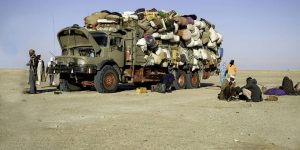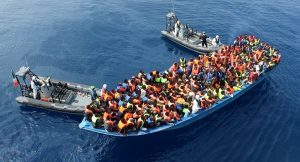Migration
Introduction
Illegal migration from Africa to Europe and America is becoming a serious challenge and a threat to humanity. Many had argued that illegal migration is the opposite of slave trade. While during slave trade, Africans were forcefully taken to Europe and America, today young African men and women risk everything, including their lives, to take on the perilous trip across dozens of borders and the treacherous waves of the Mediterranean Sea in search of greener pastures (better life) in the North (Europe and America). Some die along the way, some are turned back and some who finish the journey realize that life may not be easier across the frontier and they turn to be more frustrated considering the torture received during the dangerous journey. However, with few jobs and poverty at home, millions of African youths and young adults still choose to migrate clandestinely (illegal migration).
Such dangerous movements of people from the South (Africa) to the North (Europe and America) pose difficult questions for many governments and for the international community. One of the most pressing concerns of governments and citizens in develop countries is irregular migration: illegal entry, bogus marriages, overstaying temporary admissions, abuse of asylum systems and the difficulty of removing unsuccessful applicants.
Migration is currently at the centre of disagreements between the mainly poor sending countries (Africa and Middle East) and the richer receiving nations (Europe and America). Today the world is more connected than ever thanks to globalization. Information, commodities and money flow rapidly across national boundaries, a phenomenon often referred to as globalization. But while develop countries are promoting easier flows of capital, goods and services (which they mainly supply), they are at the same time restricting the movement of labour, which comes mainly from developing countries. Developing countries view this as a double standard, especially since labour is an important factor in the production of goods and services.
Arguments for and Against Migration
 According to the late UN Secretary-General Kofi Annan, Migration brings with it “many complex challenges,” The issues include: human rights, economic opportunity, labour shortages and unemployment, the brain drain, multiculturalism and integration, and flows of refugees and asylum seekers. Policy makers also must grapple with issues of law enforcement. Especially in the wake of the terrorist attacks on the US in 2001, many are focusing on human and national security.
According to the late UN Secretary-General Kofi Annan, Migration brings with it “many complex challenges,” The issues include: human rights, economic opportunity, labour shortages and unemployment, the brain drain, multiculturalism and integration, and flows of refugees and asylum seekers. Policy makers also must grapple with issues of law enforcement. Especially in the wake of the terrorist attacks on the US in 2001, many are focusing on human and national security.
Despite the challenges associated with migration, the late UN Secretary-General Kofi Annan remained positive stating that:
“We cannot ignore the real policy difficulties posed by migration but neither should we lose sight of its immense potential to benefit migrants, the countries they leave and those to which they migrate.”
Owing in part to labour shortages in certain sectors, an expanding global economy and the long-term trend of ageing populations, many develop countries need migrants. They face shortages in highly skilled areas such as information technology and health services, as well as in manual jobs in agriculture, manufacturing and construction. Many turn a blind eye to irregular migration to fill jobs locals do not want to take on but there are limits to the number of migrants they can take, for a number of reasons, including rising national unemployment. Some countries of the European Union, for example, have a growing number of “underutilized” workers, who are either unemployed or forced to work part-time. In France and Italy, the rate of underutilized labour reached 21 per cent in 2004, up from 17 per cent in 1994. As a result, more receiving countries are becoming more selective about the migrants they are willing to take in, opting mainly for those with skills or capital to invest.
In contrast, developing countries are demanding more open policies. They view migration as offering an opportunity to reduce the ranks of the unemployed, earn revenue through the remittance of workers’ earnings, and import skills, knowledge and technology via returning residents. Yet they are also concerned about losing skilled workers to richer countries, a process referred to as the brain drain. Aware of the detrimental effect of such migration, some have introduced measures to reduce the departure of people whose skills are needed, such as doctors and nurses by offering them better conditions of work.
How to develop comprehensive policies to manage all these issues is daunting. According to Mr. Dhananjayan Sriskandarajah of the Institute for Public Policy Research in the US, Migration is today at the point where international trade was 50 years ago, for many at that time, the current governance system for international trade was unimaginable. Mr Dhananiayan further stated that:
“Those thinking about a new international framework for managing migration face remarkably similar challenges,” and “How to design a system that leads to freer and fairer flows of people, skills and remittances?”
Factors Causing Migration
 Demographic imbalances, economic inequality, increased globalization, political instability and climatic changes are the major causes of migration from Africa to Europe and America. As an important force of development in sending (Africa) and destination regions (Europe and America), migration forms a top-priority issue in the global policy debate. To assess the impact of future migrant flows and to develop appropriate policies to manage them, knowledge of their size, composition and distribution is crucial.
Demographic imbalances, economic inequality, increased globalization, political instability and climatic changes are the major causes of migration from Africa to Europe and America. As an important force of development in sending (Africa) and destination regions (Europe and America), migration forms a top-priority issue in the global policy debate. To assess the impact of future migrant flows and to develop appropriate policies to manage them, knowledge of their size, composition and distribution is crucial.
Conclusion
Most African youths who seek to migrate are pushed by circumstances in their home countries. War, poverty and persecution prompt them to become refugees, asylum seekers and labour migrants. In most emigrant-producing countries in Africa, jobs are scarce or salaries are too low, obliging young Africans to seek opportunities elsewhere. These are fundamental challenges to be addressed within the African countries to resolve the issue of emigration of young africans to Europe and America. Therefore, in times of peace, governments in Africa can stem the flow of citizens seeking to leave by creating jobs.
